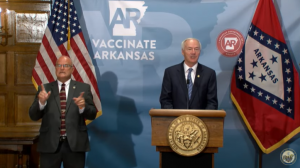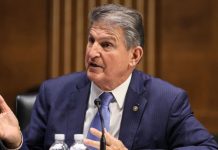Arkansas is in trouble. As a result of the lower-than-national average COVID-19 vaccination rates combined with the virility of the Delta strain, Arkansas Gov. Asa Hutchinson has declared, “Arkansas on Tuesday ran out of intensive care unit beds for COVID-19 patients for the first time since the corona virus pandemic began, as a surge in cases continued overwhelming hospitals in the state.”
The AP News network reports “Arkansas ranks fifth in the country for new cases per capita, according to figures compiled by Johns Hopkins University researchers” and “has one of the lowest vaccination rates in the country, with 40% of the state’s population fully vaccinated.” Hutchinson added, “I share that because everybody should know the strain this is on our hospitals and the need to get our vaccinations, and how critical our bed space is.”
“It fluctuates day by day but, right now because of the increased number of COVID patients that need that type of ICU care, those beds are full right now.”

In fact, a study conducted by The University of Arkansas for Medical Sciences’ (UAMS) Fay W. Boozman College of Public Health (COPH) under the auspices of the Arkansas Public Health Pandemic Working Group (APHPG) found some concerning trends and projections, including:
- The COVID-19 positivity rate in the state remains over 20%, five times the national average.
- Although testing rates are low, this is evidence of wide community spread.
- The 15-day model is forecasting 4,523 new COVID-19 cases on Sept. 14. This represents almost a doubling of new daily cases in the next month.
- The 30-day models continue to show Arkansans between ages 35 and 59 have the highest number of COVID-19 diagnoses — forecast to increase by 19,610 cases, an average of 1,040 cases per day.
- The highest relative growth in cases will be in children 17 and under. The state will see an additional 10,784 children with COVID-19 by Aug. 30, an increase of 17% over the number reported on Aug. 15.
As the Delta variant rips its way through Arkansas, the Natural State is caught in a dangerous vaccination catch-up dynamic, with less than 46% of its citizens fully vaccinated and just under 14% partially vaccinated, according to the Arkansas Department of Health (ADH). The ADH indicates that five counties, Benton, Washington, Faulkner, Pulaski, and Hot Spring, currently lead the pack in COVID-19 infections, and that broken down by race, White and Not Hispanic or Latino are the groups most commonly reported with COVID-19 infections.
And unlike the Alpha strain which kicked off the pandemic in 2020, the Delta variant seems to be causing more problems for the 25-44 Years age group, which leads all age groups in reported cases. However, consistent with the Alpha strain, the most vulnerable group in Arkansas is the 65+ Year group, which represents the largest percentage of people hospitalized or dying as a result of COVID-19 infections.
Furthermore, the projections from APHPG forecast “38 new deaths due to COVID-19 on Sept. 14” which is “just under a doubling of daily deaths over the number on Aug. 16,” and expected “average of 30 additional deaths per day.”
Furthermore, APHPG is concerned about the low vaccination rate in Arkansas, stating, “All counties in Arkansas continue to show low COVID-19 vaccination rates. The greatest increase in vaccinations in the state was 11% in Sebastian County. However, most counties increased vaccinations by 2% to 5%.: This glacial rate of vaccinations is the primary driver of COVID-19 hospitalizations and morbidity, causing a strain on the ability of hospitals to offer ICU beds for their patients.
Even more worrisome is how this latest surge stacks up in comparison to the previous wintertime surge. “This surge is so much more difficult for us to place patients than the winter months, by far,” said Jeff Tabor, the program manager for the COVIDComm system in Arkansas.
The overall picture is complex. As the American Society for Microbiology(ASM) reports, “. . .it is difficult to determine whether Delta is actually making people sicker than previous forms of the virus or if it is simply circulating amongst more vulnerable populations where case numbers are high, vaccination rates are low and increased stress on hospital systems is impacting patient care and disease outcomes.”
The key to understanding the impact of the Delta variant, and therefore a coherent, clearly-articulated, comprehensive response, may be getting a handle on the transmissibility aspect of the strain. In particular, the Delta variants, according to the most current data, appear to be much more transmissible than previous strains, as measured by R0.
Pronounced “R naught,” R0 is a mathematical term that indicates how contagious an infectious disease is and is commonly known as the “reproduction number.” According to healthline.com, “R0 tells you the average number of people who will contract a contagious disease from one person with that disease. It specifically applies to a population of people who were previously free of infection and haven’t been vaccinated.” Essentially, R0 is how easily a disease is spread, so the higher the R0, the more contagious it is, and vice versa.
With regard to the Alpha variant, the R0 was estimated as an average of approximately 3.32, with some estimates as low as 2 (in line with the common flu), meaning for every person who carries the virus, they will infect around 3 other people. A desirable R0 is 1 or less because at this rate, the pandemic will either be easily contained or eventually die out.
However, the Delta variant is especially challenging, because the Journal of Travel Medicine “. . . found a mean R0 of 5.08 which is much higher than the R0 of the ancestral strain of 2.79” concluding that “[Rapidly ramping up vaccine coverage rates while enhancing public health and social measures is now even more urgent and important.” Part of the problem with the Delta variant is that this strain has a much higher viral load, meaning the overall presence of the virus in our physiological systems. As APHPG points out, “Persons infected with the Delta variant have 10,000 times more virus in their nasal cavity than was the case for the original strain.”
To understand the overall impact of the R0 number, you have to do a little exponential math. A recent article by Michaeleen Doucleff, who has a doctorate in physical chemistry from the University of Berkeley, California, and a master’s degree in viticulture and enology from the University of California, Davis, uses the following example to illustrate the magnitude of difference in R0 numbers:
“The difference between an R0 of three and six is massive. For example, with the original strain of SARS-CoV-2, one person would infect about three people, and each of those people would infect three more. So after only two rounds of transmission, cases would rise by nine (3 x 3 = 9). After three rounds, cases would rise by 27 (3 x 3 x 3 = 27). But with the delta variant, the first person would infect six others, who would each then infect six more people. So after two rounds of transmission, cases would already rise by 36 (6 x 6 = 36). After three rounds, cases would surge by 216 (6 x 6 x 6 = 216).”
Beyond the issue of transmissibility is the factor of human behavior, a dynamic that is difficult for scientists to get their collective arms around, though there are some patterns emerging. For example, take the controversial issue of mask mandates. As Dylan Scott recently wrote, “because the pandemic has become so politicized, people have already sorted themselves into their different camps, experts indicated — and so a state mandate might not have changed behavior. By now, you are already either a mask-wearer or you’re not. A government mandate probably isn’t going to affect someone’s behavior in June 2021 as much as it would have a year ago, especially after enforcement has been nonexistent.”
This human behavior factor can’t be underestimated. As APHPG puts it, “What the models cannot take into account are changing human behaviors. The major change in the last week is the opening of schools and colleges. Children and young adults are congregating in small spaces, some without masks. The other event in the next weeks is the Labor Day holiday weekend. If we have learned nothing else from the pandemic, COVID-19 loves a holiday party. Because of these two events, we should expect a first surge five to ten days after the beginning of the school year, and another five to ten days after the holiday weekend.”
The bottom line is that while the future of COVID-19 is difficult to gauge, it looks like the Delta variant is not going away anytime soon, and is going to have a significant impact on our medical systems, especially the availability of our ICUs. Still, there are some basic lessons we can lean on for guidance. Alex Madrigal, writing for The Atlantic, offers the following guidelines:
- The vaccines work very well to reduce the likelihood of an individual being hospitalized or dying from COVID-19.
- Even high levels of vaccination in local regions are not enough to prevent the spread of the Delta variant.
- There is still a lot of randomness as to where the worst outbreaks occur.
- Kids remain at the lowest risk of any group for hospitalization and death. And kids are at higher risk of hospitalization now than ever before in the pandemic.
- Vaccinated people can be infected with and transmit the virus.
The reality going forward is that there is still more unknown than known about the pandemic, a strange sort of psychological side-effect that creates a free-floating form of anxiety. At the end of the day, however, Americans are an intelligent, bunch, and we will weather this viral storm much like we weathered many other tragedies and challenges. Perhaps the most important thing, then, is to continue to care about one another, whether or not we wear masks or are vaccinated.
At Newsweed.com, we adhere to three simple principles: truth, balance, and relatability. Our articles, podcasts, and videos strive to present content in an accurate, fair, yet compelling and timely manner. We avoid pushing personal or ideological agendas because our only agenda is creating quality content for our audience, whom we are here to serve. That is why our motto is ”Rolling with the times, straining for the truth.”
Your opinion matters. Please share your thoughts in our survey so that Newsweed can better serve you.
Charles Bukowski, the Los Angeles beat poet that captured the depravity of American urban life once said, “There is something about writing poetry that brings a man close to the cliff’s edge.” Newsweed is proud to stand in solidarity and offer you a chance to get close to the cliff’s edge with our first Power of Poetry Contest. Are you a budding bard, a versatile versifier, a rhyming regaler? Do you march to the beat of iambic pentameter, or flow like a river with free verse? If so, here’s your opportunity to put your mad poetic chops to the test. Enter our poetry contest for bragging rights and an opportunity to win some cash!






